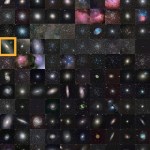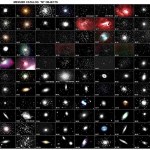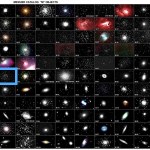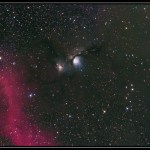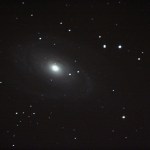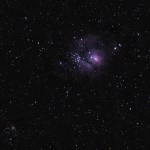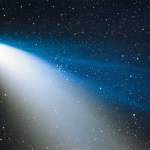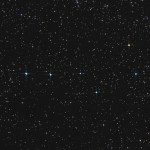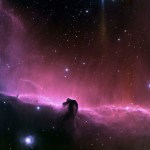nebula
"We find them smaller and fainter, in constantly increasing numbers, and we know that we are reaching into space, farther and farther, until, with the faintest nebulae that can be detected with the greatest telescopes, we arrive at the frontier of the known universe." -Edwin Powell Hubble
With 110 deep-sky objects scattered throughout the heavens, the Messier Catalogue provides skywatchers across the globe with a number of spectacular targets, from nearby nebulae and clusters to spectacular, distant galaxies. Each Monday, we spotlight a new one right here.
Image credit: Rolando Ligustri,…
"Pinwheel, pinwheel spinning around. Look at my Pinwheel and see what I found.
Pinwheel, pinwheel, breezy and bright. Spin me good morning, spin me good night." -Janet Gardner
It's time for another Messier Monday, where each week, one of the 110 deep-sky objects that make up the famed Messier Catalogue -- the first large, accurate catalogue of non-cometary objects -- gets an in-depth treatment. These objects are not only a good representation of the brightest deep-sky objects visible from Earth, they're a good sample of the different types of objects visible from any random location in the…
"Why I came here, I know not; where I shall go it is useless to inquire - in the midst of myriads of the living and the dead worlds, stars, systems, infinity, why should I be anxious about an atom?" -Lord Byron
Welcome back to another Messier Monday here on Starts With a Bang! Messier's 18th-Century catalogue of 110 deep-sky objects that could potentially be confused with comets by skywatchers has endured as one of the greatest collections of deep-sky objects clearly visible to amateur and professional astronomers worldwide!
Image credit: ScienceSouth - Tony's Astronomy Corner, via http://…
"Look within. Within is the fountain of good, and it will forever bubble up, if forever you dig." -Marcus Aurelius
Welcome back to yet another Messier Monday! Each week, we're taking a look at one of the 110 fixed, deep-sky objects -- not to be confused with comets -- that made up Messier's original catalogue.
Image credit: ScienceSouth - Tony's Astronomy Corner.
Today, we're going to take a look at Messier 52, one of the 33 open star clusters in Messier's catalogue, which happens to be right on the edge of the Milky Way galaxy. It's one of the easiest Messier objects to find, as to get…
"A wise old owl lived in an oak
The more he saw the less he spoke
The less he spoke the more he heard.
Why can’t we all be like that wise old bird?" -The Immortal Poet Bromley
To your naked eye, the night sky appears littered with thousands of individual points of light: the stars and planets so familiar to us. But through even a small telescope or a pair of binoculars, not only do the number of visible stars increase into the hundreds-of-thousands or even the millions, but a slew of deep-sky objects become visible to us as well. Each monday, we highlight one of the deep-sky objects from…
"My role in society, or any artist's or poet's role, is to try and express what we all feel. Not to tell people how to feel. Not as a preacher, not as a leader, but as a reflection of us all." -John Lennon
Welcome to the latest edition of Messier Monday, where each week we take an in-depth look at one of the 110 deep-sky objects in the Messier Catalog. These objects, all of which are visible from certain northern latitudes at certain times of the year, were catalogued explicitly to prevent comet-hunters from confusing these static objects with potential comets.
Image credit: SEDS Messier…
"When you look at the stars and the galaxy, you feel that you are not just from any particular piece of land, but from the solar system." -Kalpana Chawla
Welcome to this week's Messier Monday, where I pick a new object out of the original catalogue of 110 "faint fuzzies" designed to help comet-hunters avoid confusion with these fixed, extended night sky objects.
Image credit: The Messier Objects by Alistair Symon, from 2005-2009.
In previous weeks, we've focused on a variety of objects, including a globular cluster, an open star cluster, a supernova remnant and an active star-forming nebula…
"I hate that expression, 'fusion.' What it means to me is this movement where nothing ever really fused." -Wayne Kramer
Welcome to another Messier Monday, where each week, I pick one of the 110 Messier Objects -- deep-sky objects catalogued to avoid confusion for comet hunters -- to highlight and detail.
Image(s) credit: SEDS -- http://messier.seds.org/.
This week, I'd like to highlight one of only two star-forming nebulae visible to the naked eye in the night sky, and I want to do it before it disappears completely for the year! Visible for just an hour or so after sunset right now towards…
"This nebula had such a resemblance to a comet in its form and brightness that I endeavored to find others, so that astronomers would not confuse these same nebulae with comets just beginning to shine." -Charles Messier
Let's take a journey back in time to when our known Universe was a lot smaller. The only planets discovered were Mercury through Saturn: the naked eye planets. The well-known objects were our Moon, the (naked-eye) planets and their moons, and the stars and the Sun. After those, the only new objects that were routinely hunted in the night sky were those two-tailed recurring…
"I would rather be adorned by beauty of character than jewels. Jewels are the gift of fortune, while character comes from within." -Plautus
When it comes to astronomy, there's no doubt that I've got a northern hemisphere bias. It's no surprise, of course; I live here. And while I often write about the skies that we all share, astronomy has a historical bias in favor of the northern hemisphere. You know this, too. Ask most people to name one single thing in the night sky, and you're most likely going to end up with this.
Image credit: Rich Richins of http://www.enchantedskies.net/.
The Big…
Ever seen the Horsehead Nebula? If you look at the easternmost star in Orion's Belt through a telescope, you're likely to see something like this (the star is just off the image to your left):
A pretty little nebula, to be sure, but it doesn't look all that spectacular. I mean really, there's a fancy emission nebula behind some dust, that happens to look like a horse's head. It's mostly cloud-watching in space.
But then I saw a picture where Star Shadows Remote Observatory decided to over-expose the horsehead nebula and the area around it. Now, overexposing a region of sky is how you see…
